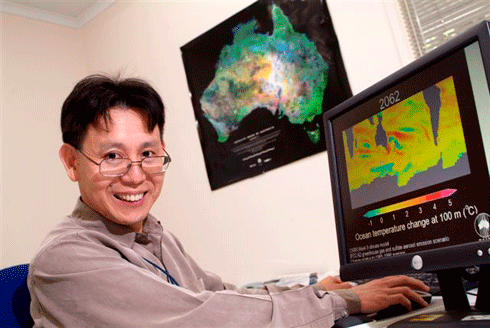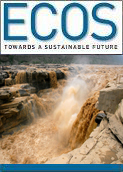
|
Published: 3 December 2012
Wenju Cai: revealing oceans’ role in climate change
Wenju Cai – known as Cai (pronounced ‘Chai’) – grew up in a small coastal village in the southern China province of Fujian. Cai talks to ECOS about moving to Australia, his CSIRO research into climate science, and why the ocean is so important.

|
|
Wenju Cai is one of Australia’s most respected oceanographers. Credit:
CSIRO
|
The son of poor farmers who valued education, Wenju Cai studied marine acoustics at the nearby Xiamen University (now known as Amoy) and graduated as an oceanographer. Chance intervened with a 1984 visit by a delegation led by then Prime Minister, Bob Hawke. As a result of this visit, which aimed to strengthen academic ties between Australia and China, Cai was offered a PhD scholarship to Flinders University in Adelaide.
What was it like when you arrived in Adelaide compared to your life in China?
It was a total culture shock. I came from a very poor farming community; in my village we didn't actually have a school. When I was a farming boy, life was really tough.
When I finished high school, I got a very good mark that took me to university. Back then it was unheard of for a countryside boy to go to university. Just going to university was exhilarating. You are in the city; you have so much good food, rice and sometimes a bit of meat. But then, coming to Australia, it was another big shock: so much of everything; so rich in terms of food; so quiet and so spacious; such a beautiful place.
What is your current role in CSIRO?
I joined CSIRO in 1990 and am currently a senior principal research scientist and a stream leader, leading a portfolio of many projects. I am also a CSIRO Office of the Chief Executive Science Leader, and that allows me to collaborate widely and do strategic science. This year we had four papers in high-impact journals such as Nature1, Nature Scientific Report2 and Nature Climate Change3. I am grateful to CSIRO and my colleagues for the support.
You work in oceanography, but your focus is climate science. When did this interest develop and could you explain the link?
In mid-1990s, it became very clear that the ocean is the key to many things. Our long-term climate has a lot to do with our oceans, even oceans remote from Australia, such as the equatorial Pacific and Indian Oceans. They play a big part in the generation of rainfall and rainfall variability.
The atmosphere has a memory of about a week. But for ENSO (the El Niño-Southern Oscillation), the equatorial Pacific memory is many months. When you are predicting something, you are trying to look for a precursor of the actual thing that occurs. So, the sea surface temperature warms up during El Niño in the equatorial eastern Pacific, but in the subsurface ocean, that signal arrives seven to nine months earlier: and that gives you this predictability.
Were you surprised to find the ocean was the key?
No, not really. The Chinese character that describes today's ocean is exactly the same as 3000 years ago. The character for 'ocean' consists of three parts: one part is human, another is a mother breastfeeding a baby in bed, and the third part is water. So, 3000 years ago, the Chinese ancestors interpreted ocean as 'mankind's mother with water'.
To me, that understanding is very profound. We now realise that almost everywhere, whether you get good rain or not depends on the behaviour of the ocean.
By mid-1990s we had a reasonable understanding of El Niño. Did we have much understanding of the Indian Ocean Dipole?
No, at that time people were still thinking that the Indian Ocean is a slave to the Pacific; then, papers were published in Nature4,5. We realise now that the Indian Ocean is very important; in fact, if we are looking at winter and spring over southern Australia, the Indian Ocean Dipole is perhaps more important than El Niño.
Now we realise that for the Pacific El Niño to deliver an impact to southern Australia, it has to be delivered through the Indian Ocean, because there is no other pathway.
Tell us about your recent research.
Our climate system is heated up by the sun mainly through the tropics. The oceanic gyres or currents send the heat to the polar regions. Atmospheric circulation called the Hadley cell circulation also delivers the heat to the higher latitudes. High-moisture hot air that rises in the tropics goes poleward at 10 to 15 kilometres, then it sinks down in the mid latitude. These mid-latitude areas are what we call dry zones, because the air that sinks is dry air.
Under climate change, the whole Earth system is heated more, causing the oceanic gyres3, dry zones and the Hadley cell2 to expand polewards.
Southern Australia is situated in the latitude of dry zones. One paper we published recently2 finds that expansion of the dry zone is accounting for most of the April–May rainfall reduction over southern Australia, which has declined by about 40 per cent since 1950.
We may have thought that the drought has broken in the last two or three years, but if you look at the April and May rainfall – which continues to be below the long-term average – then the drought hasn't broken yet.
This dry zone is expanding. It is caused by climate change. The position of the dry zone will still fluctuate, but in the longer term, we expect it will continue to shift polewards.
What problems would you like to tackle?
One of our major papers, published in August this year1, looked at extreme events in the Pacific Ocean. These are affected by El Niño. We found these extreme events will increase in frequency in the future, but at the moment, we are trying to tackle this issue of how El Niño and the Indian Ocean Dipole may change in a warming climate.
This continues to be one of the most difficult and important issues for the world, and particularly for Australia. El Niño, for example, drastically shifts the probability of extreme events, heat waves, droughts, floods, and bushfire.
I feel we need to revisit this issue. It is a challenging one, but we can focus on individual aspects before we tackle it in a systematic way. At the moment, I have substantial resources devoted to this research and have an international team of collaborators, so I am hoping we will make some real progress. I know it is getting harder, but it is worthwhile.
1 Cai W et al. (2012) More extreme swings of the South Pacific convergence zone due to greenhouse warming. Nature 488: 365–369.
2 Cai W et al. (2012) Rainfall reductions over Southern Hemisphere semi-arid regions: the role of subtropical dry zone expansion. Scientific Reports 2:702| doi:10.1038/srep00702.
3 Wu L et al. (2012) Enhanced Warming over the Global Subtropical Western Boundary Currents. Nature Climate Change 2: 161–166.
4 Saji NH et al. (1999) A dipole mode in the tropical Indian Ocean. Nature 401: 360–363.
5 Webster PJ et al. (1999) Coupled ocean–atmosphere dynamics in the Indian Ocean during 1997–98. Nature 401: 356–360.




